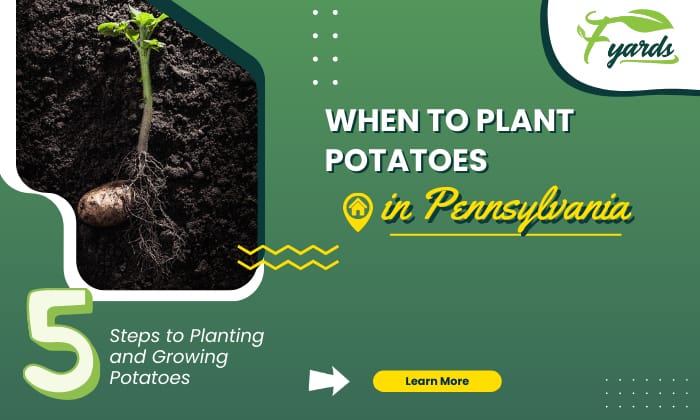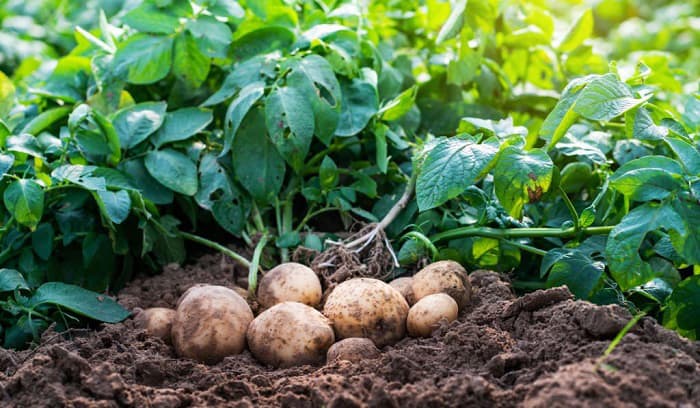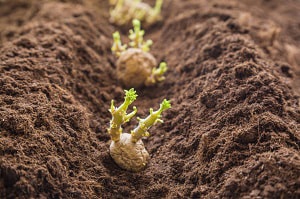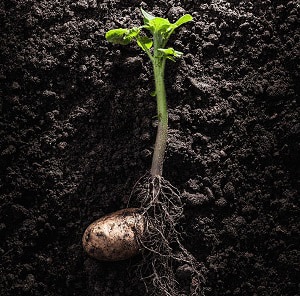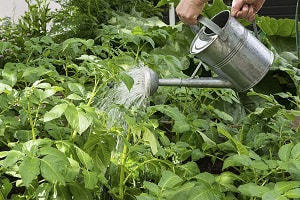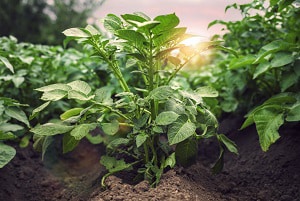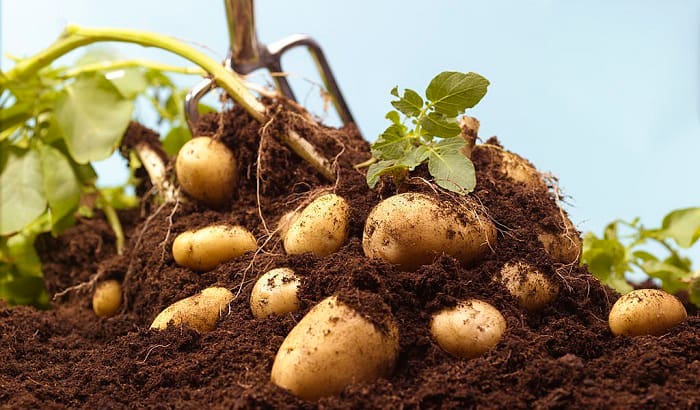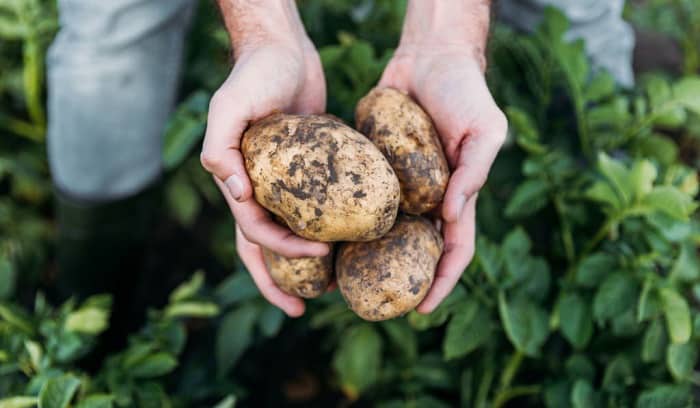Potatoes are among the top vegetable crops in the United States. These tubers are a good source of vitamin C and potassium, and they store well, which is especially important during winter months.
If you are planning to grow them in your backyard, knowing when to plant potatoes in Pennsylvania is important to ensure healthy crops and a good harvest. In PA, potatoes are usually planted in spring, from early to mid-May, when the ground is no longer freezingly cold.
Table of Contents
Best Time to Plant Potatoes in Pennsylvania
Pennsylvania has a combination of different climates – the northern part has a humid continental climate with hot summers and cold winters, while the southern region has a humid subtropical climate characterized by hot and humid summers and mild winters.
This mix puts Pennsylvania in USDA hardiness zones ranging from zone 5 to zone 7, but most cities are in zone 5b to zone 6b.
The ideal month to plant potatoes varies depending on your hardiness zone, and your region’s first and last frost date, as these plants cannot withstand freezing temperatures.
- To ensure that the threat of frost is no longer there, plant potatoes about 2 weeks after your region’s last frost date.
Pittsburgh, for example, is in Zone 6, and the last spring frost was on April 30, and the first fall frost is likely to be on October 21. Given this, in Pittsburgh, Pennsylvania, growing season spans about 173 days, and factoring in the two-week wait, you can plant your potatoes a few days after May 15.
- If you are looking to have an autumn harvest, plant the potatoes 12 weeks before the first fall frost. In Pittsburgh, that would be around July 21.
Also, if your city is in zone 7, check this guide to know the best time to plant tomatoes here!
Planting and Growing Potatoes
Potatoes grow not from actual seeds but from another potato tuber which acts as the seed. Commercial farmers and gardeners plant tubers containing an “eye” which sprouts and develops into a new potato plant.
It does not take a lot for a potato to grow in Pennsylvania climate. Once you’ve determined what your growing zone is, Pennsylvania residents can start gardening potatoes.
Things you’ll need:
- Gardening tools
- Well-drained soil
- Seed potatoes
- Fertilizer
Step 1: Prepare the soil
- Potatoes grow well in soil that is fertile and has good drainage. Otherwise, the potato tuber will be susceptible to rotting and diseases.
- Another thing to consider is the soil acidity. It should ideally be between the pH range of 6 to 6.5 but some varieties can grow well in soils with pH of 5.
If you are not sure about your soil’s acidity, you can consult your local agriculture department or a soil testing lab within your area.
Step 2: Purchase the seed tubers
Growing potato plants using store-bought potatoes is oftentimes discouraged as these tubers might be carrying bacteria and diseases and could introduce them to your garden and affect your other plants.
Aside from that, they might also be sprayed with enzymes that inhibit the growth of the tubers, which will make your gardening efforts futile.
Instead, you can purchase seed tubers from local garden centers or certified seed distributors to ensure that the potatoes you will grow are healthy and disease-free.
Step 3: Plant your seed tubers
Spacing and the correct planting depth for potatoes are crucial for the size and yield of your crops. Plant the tubers cut side down 3 to 5 inches deep into the soil and 10 to 12 inches apart from each other.
Once the stems emerge and the plant is about 1 foot tall, start hilling around the main stem. This method gives more space and cover for the newly developed tubers to grow and expand.
Step 4: Water your plants thoroughly
When watering your potato plants, make sure that the soil is soaked thoroughly. However, be careful not to overwater. Potatoes need about 1 to 2 inches of water in a week and going beyond this might result in misshapen tubers or make the tubers susceptible to diseases.
Step 5: Watch out for pests and diseases
Regularly check your plants for the presence of pests and diseases. Potatoes are susceptible to pests like Colorado potato beetles and cutworms. Diseases like early blight and late blight can cause serious damage to your crops if not addressed immediately.
Harvesting and Storing Potatoes
The length of the growing season of potatoes varies depending on the variety. Indications that the potatoes are ready for harvest is when the plant has dried out and the tubers have reached the desired size.
Avoid harvesting when the soil is wet and carefully remove the potatoes from the ground, making sure that you do not puncture the tubers as this will introduce bacteria from the soil and cause early spoilage.
In case you have accidentally damaged some of the potatoes, separate them from the rest and use them first.
Mature potatoes store well as they already have thick skins. Store them in dark, cool, and humid places like your refrigerator.
Frequently Asked Questions
Can you plant potatoes in July in Pennsylvania?
Yes. Potatoes planting season can start from around April up until about August, depending on your region. If you are aiming to harvest potatoes in autumn and store them for winter, then summer planting can be started in July.
When is it too late to plant potatoes in Pennsylvania?
Growing potatoes in September might already be too late. Since they are sensitive to freezing temperatures and the first fall frost in Pennsylvania is just around the corner at this time, potato plants might not be able to grow and develop new tubers properly.
What kind of potatoes grow in Pennsylvania?
Different varieties of potatoes are cultivated in Pennsylvania. Among the most popular are russet potatoes, Yukon Gold, Atlantic, Snowden, Katahdin, Eva, and Elba, among others.
What are the best and worst companion plants for potatoes?
Potatoes can thrive when they are planted together with cabbage, corn, chives, or cilantro as they tend to attract beneficial insects and don’t compete for space or nutrients with your potato plants. Sweet potatoes, although they are not related, are also good companion plants for potatoes.
Carrots, onions, tomatoes, and eggplants, on the other hand, should not be planted near your potato plants. Tomatoes and eggplants belong to the same family as potatoes and are susceptible to the same diseases while carrots and onions can compete with potatoes for space and nutrients.
Conclusion
Potatoes are a great crop to grow in your garden as they are not only a good source of energy and vitamin C, but they are relatively easy to care for as well. Knowing when to plant potatoes in Pennsylvania and the correct growing techniques, you’ll be growing your own healthy potatoes in no time.

Hi, I am William – Floridayards’ digital content creator. My job is to find answers to all your concerns with thorough research and our team’s expert advice. I will also bring you honest reviews on the best products and equipment for raising your beautiful garden. Please look forward to our work!


